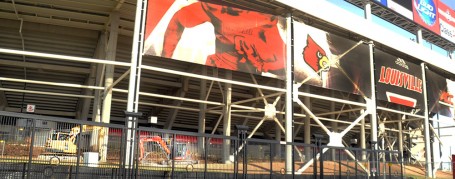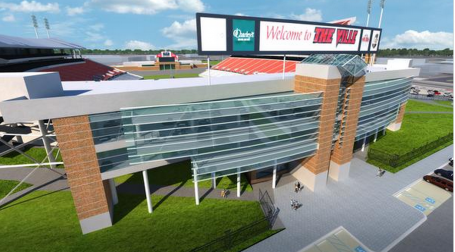 Some earth moving equipment is already on the scene at Papa John’s Cardinal Stadium, with some of the preliminary work being done on the Thornton’s Center for Academic Excellence for University of Louisville athletes.
Some earth moving equipment is already on the scene at Papa John’s Cardinal Stadium, with some of the preliminary work being done on the Thornton’s Center for Academic Excellence for University of Louisville athletes.
The ongoing work will inevitably affect the current main entrance at the south end of PJCS during the 2015 season, requiring special preparations for the secondary entrances of the stadium. The metal fence will have to come down, of course, and some tailgaters may need to quit partying earlier to get to their seats in time for kickoff.
At least one architectural rendering (below) appears to indicate that the south end will continue to be the main entrance. Ground-floor walkways through the center of the facility will provide fans with some interaction and appreciation for the the new center.
The exterior of the academic center will be striking, adding a unique and majestic new look to the stadium. The 40,000-square-foot facility will have tutorial space, laboratories, and offices and classrooms to serve more than 750 student-athletes across the university’s 23 sports.
Vice President of Athletics Tom Jurich has indicated that construction probably will begin in late March, with completion expected in time for the 2015-16 academic year.

I have to reply to the assertion that the revenue used to build this facility is coming from the U of L itself. This is not a zero-sum game. If U of L builds a new stadium, it does not mean that a high school can’t build an auditorium. If the local school board decides two gyms is better than one auditorium, I’d look at the school board rather than vent about U of L providing better learning facilities for it’s athletes.
Few people realize that the athletic programs generate a fairly sizeable revenue stream which goes to fund ALL athletic programs (hence we love to go to post-season games-for the money, not just exposure). Money received through bowl games and television rights, go to pay coaches salaries and other athletic program costs.
Making it easier for a college athlete to progress academically can always be debated, but I think it pales in comparison to other wasteful and unnecessary Tuition-based expenditures that seem to go unnoticed.
Go Cards
Thanks, Lucy, for your comments. I am a liberal arts school grad, so I will always chafe at the extra attention athletes get. They make money for and add celebrity to their school, so they “earn” these perks, right? Our own community (and probably the whole state) has its priorities skewed when high schools get two gymnasiums and not even one true auditorium. Concerts, theatrical productions, presentations take place in a “gymtorium” with foldling chairs placed on a protected playing court in front of a proscenium stage with tiny rooms on the side for drama classes or orchestra rehearsals. That is the sad state of our basketball-crazed commonwealth.
Enough money is spent on athletics. Do athletes need a special place to learn? Let them study hard and learn like the rest of students. Use the money to improve places such as Speed School where there’s more written on a blackboard than simply plays on a field. Come on U of L get your priorities straight!
Thanks for your comment, Lucy. I believe we all want all students to get the most from their college experiences. Speed School has some fine programs and some generous donors, and I’m sure they are providing ample resources for that school. If it has been determined better facilities are need to raise academic progress of athletes, and the athletic program is raising the funds, then it’s probably a positive development for the university. I’m pretty confident they won’t be outlining plays on the blackboard or, these days, in a PowerPoint presentation.
Thanks for your reply. The blackboard reference is not to be archaic, but to simply note that providing a cutting-edge environment for academic success for all students is what is crucial. Obviously, it’s been determined that athletes, some more than others, need assistance academically, but that problem is solved by spending more time studying and in class. With the construction of this building, it seems to be creating a favored sub-set of students within the university catering to a group whose main focus is sports, not academics. Most students who had obligations that left them with little time to study or be in class would be bereft of their scholarships, and dropping out. Perhaps the center will allow non-athletes access too. After all, it’s all about obtaining a championship education, right? Hats off to diligent athletes who play hard and study harder. Go Cards.
You may be pleased to know that your sentiments echo those of my wife, another strong UofL fan. Not a bad idea sharing the facility.
Lucy’s complaint is an old one, (I first heard it raised by Dean of A&S Arthur J Slavin in the mid-1970s), and the idea of an academic center for athletes only leaves me with a vaguely uncomfortable feeling. The skeptic might ask, will said Center result in better academic performance for the athlete or more opportunity grade manipulation keeping players eligible? I am curious to know what benefits are supposed to accrue from this separate education?